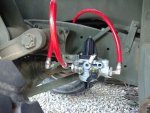TacMac2012
Active member
- 184
- 141
- 43
- Location
- Wallburg, NC
I know on a normal truck with air brakes the governor cuts the compressor 'on' and 'off', but how does the air system work on a FLU? It seems the compressor will just pump all the time, so where does the excess pressure go? I understand there is a unloader valve on the passenger side framerail that I guess acts as a sort of an air drier and spits out excess moisture, but does it constantly bleed off pressure? I have a FLU that was not building pressure so I have been going through it and am really debating removing much of the stuff that isn't needed such as front/rear gladhands and all associated hoses (such as the manual trailer hand valve, and the one in between seats). I say it is unneeded because why in the world would I attempt to pull a trailer with this thing...
I am also thinking about making the 4wd a manual lever, and making the diff locks just a ball valve. It is ridiculous how over engineered these things are, cool yes, but way too complicated.
Thank you for any assistance.
I am also thinking about making the 4wd a manual lever, and making the diff locks just a ball valve. It is ridiculous how over engineered these things are, cool yes, but way too complicated.
Thank you for any assistance.


